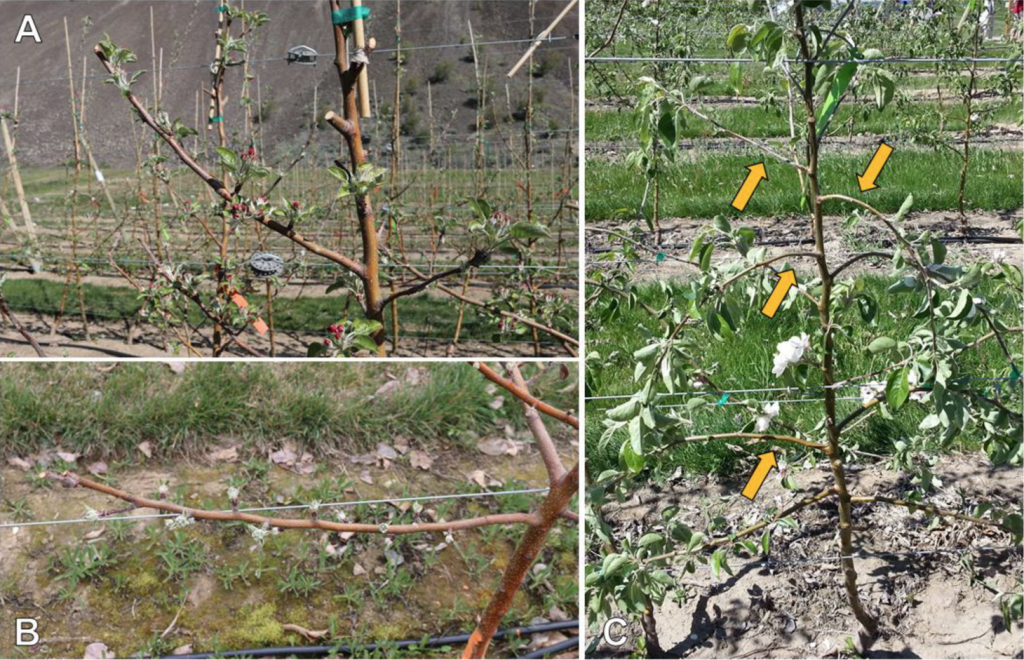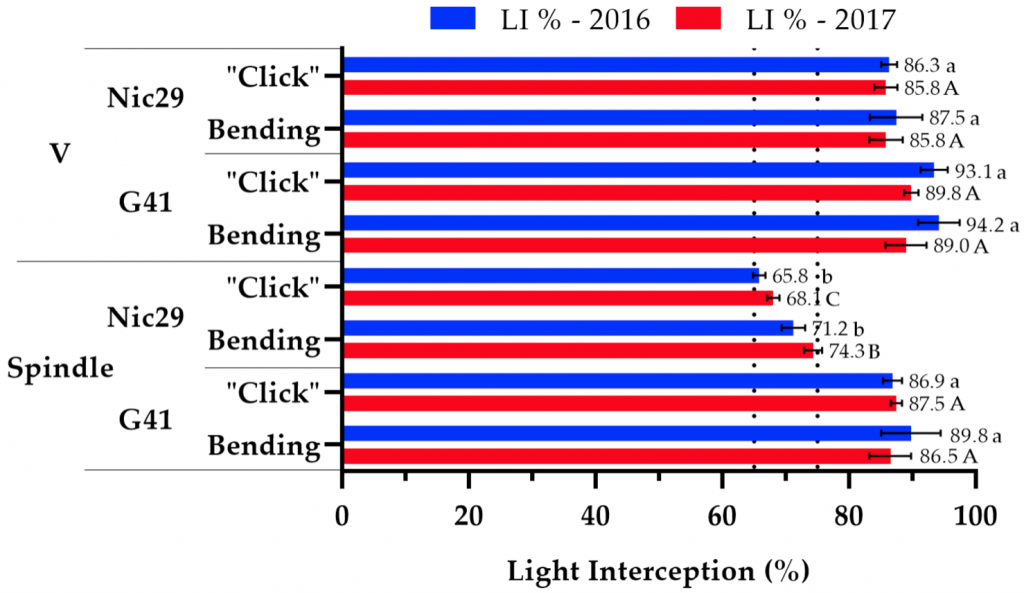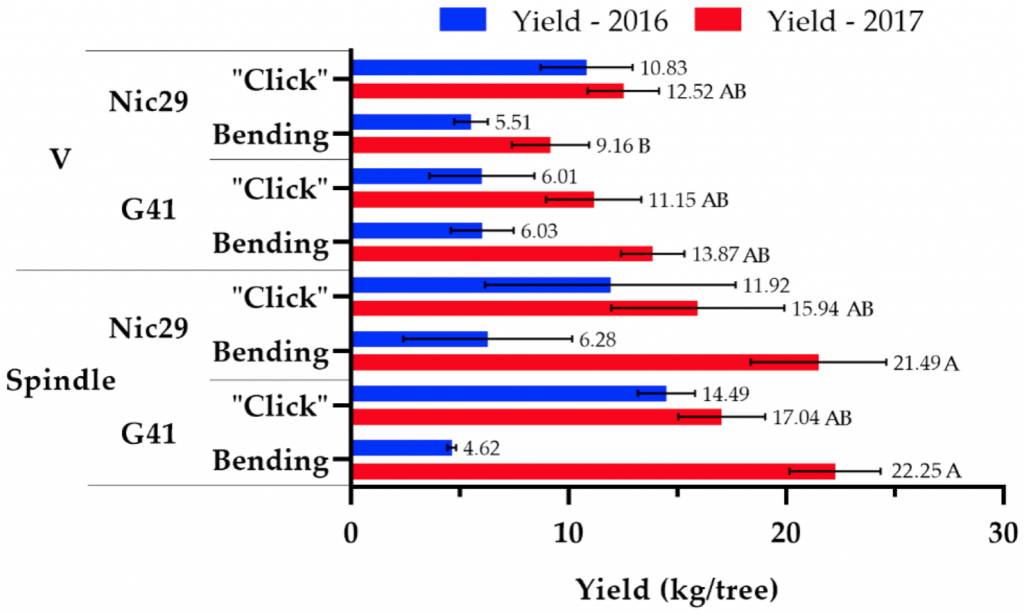Written by Brendon Anthony, Sara Serra, and Stefano Musacchi, WSU TFREC, Wenatchee, WA. June 2020.
Proper modern management of orchards should include the simplification of canopy architecture, with the efficient use of land area to maximize light interception, while balancing an even distribution of light across the entirety of the canopy. The ultimate goal of a new orchard’s design is to ensure consistent, high yields of premium quality fruit.
Leaf area index (leaf area : ground area) (LAI) and light interception have been demonstrated to relate to photosynthesis, yield and fruit quality. LAI is considered optimal in apple systems around 1.2 – 2.0, while light interception should be maintained around 65 – 75% (Jackson, 1978; Hampson et al., 2002; Robinson et al., 2013). Excessive LAI and light interception levels can negatively impact yield and quality, due to the increase of shaded areas in the canopy.
Training systems, rootstock selection and pruning techniques can all influence these parameters as they alter the way the canopy is arranged, controlled for size and/or manipulated. These horticultural selections are critically important for “WA 38,” as it is a vigorous, Type IV (like ‘Granny Smith’), tip-bearing variety that has a tendency to produce “blind wood” (Lespinasse, 1977). A pruning technique, called “click” pruning (Figure 1A), has been demonstrated to ameliorate “blind wood” and shift the tip-bearing tendency of Type IV varieties towards more basal bud production in the branches (Musacchi and Greene, 2017). This helps increase production across the entirety of the canopy and keeps fruits closer to the central leader, thus eliminating “weeping” and exhausted branches that may bend excessively due to the weight of fruit set on terminal buds.
A trial assessing different training systems, rootstocks and pruning techniques was conducted from 2016 to 2017 (fourth and fifth leaf) in a “WA38” orchard planted near Wenatchee, WA in 2013. The training systems assessed were Spindle (3’ x 10’ ≈ 1,500 trees/acre) and V (1.5’ x 10’ ≈ 3,000 trees/acre), the rootstocks were M9-Nic29 (Nic29) and Geneva41® (G41), and the pruning techniques were “click” and bending. The “click” pruning entailed simplifying branches and heading back on one-year-old shoots to 5–10 cm stubs (Figure 1B). Bending consisted of the removal of upright shoots and manipulating branches below 90 degrees to induce flowering by reducing vegetative vigor imposed by acute crotch angles (Figure 1C). The trial evaluated how these horticultural selections impacted LAI, light interception, yield and bienniality.

In total, there were eight treatment combinations in this three-way experimental design (training system x rootstock x pruning). Leaf area index was estimated with a non-destructive canopy imager and light interception was measured with a 1-m long ceptometer throughout the summer (June – August) each year.
There were no differences in LAI in 2016, while Spindle-Nic29 combinations (regardless of pruning technique) demonstrated the lowest and most optimal LAI values in 2017 (Figure 2). Overall, the V training system (given its higher density) and trees grafted to G41 (given its increased vigor in our soils) demonstrated LAI values that exceeded optimal thresholds (> 2.0) (Figure 2).

Similarly, in respect to light interception, it appears the Spindle-Nic29 combinations (regardless of pruning technique) also generated values that are considered optimal, based on reported ranges in literature (65 – 75%), across both years (Figure 3).

In both years, Spindle trees produced more on a kg/tree basis, while V produced more on a per acre basis given the increased planting density. Rootstocks did not present differences in yield in either year. In 2016, “click” pruned trees produced more than bending, but there were no differences in 2017 between pruning techniques. This is due to the biennial nature of trees that received the bending treatment, with the bending trees experiencing an “on” year in 2017 matching the production in “click” trees. Vast differences in year to year production were seen in the bending combinations, with all of them receiving a biennial classification based on their 2016 – 2017 production (Figure 4). However, “click” pruned trees all received consistent bearing classifications (I < 0.50; Figure 4).

Bending branches in “WA38” does not regulate its’ tip-bearing tendency, which sets fruit terminally, and brings branches excessively below horizontal (i.e. “weeping). This exhausts the branch, leaving large amounts of “blind wood,” without flower buds and the ability to crop in the subsequent season, hence the onset of the alternate bearing cycle.
Inversely, “click” pruning heads one-year-old wood, effectively removing terminal flower buds and stimulates lateral bud break and flower formation. This allows for an increase in production, as “blind wood” is mitigated, but also fosters consistent production as new shoots and flower buds are stimulated each year. In combination to the “click” pruning strategy, a phloem-disruption technique, such as girdling and notching above dormant buds will help reduce “blind wood” and alternate bearing tendencies in “WA38.”
In sum, the treatment combination that maintained optimal LAI and light interception thresholds in both years, while maintaining a consistent bearing pattern was the Spindle-Nic29-“click” sequence. This combination of training-rootstock-pruning is categorized by a less vigorous rootstock (in our soil conditions) and a pruning style that maintains a narrow and flower bud rich canopy to ensure consistent yields of high-quality fruit.
References
- Hampson, C.; Quamme, H.; Brownlee, R. Tree density or training system-What is important in apple orchard design? Compact. Fruit Tree 2002, 35, 48–50.
- Hoblyn, T. Studies in biennial bearing. J. Pomol. Hortic. Sci. 1936, 14, 39–76.
- Jackson, J.E. Utilization of light resources by HDP systems, In Symposium on High Density Planting 65. Acta Hortic. 1978, 65, 61–70.
- Lespinasse, J.M.; Chol, P.; Dupin, J.; Terenne, E. La conduite du Pommier: Types de Fructification, Incidence sur la conduite de l’arbre; Brochure INVUFLEC: Paris, France, 1977; p. 80.
- Musacchi, S.; Greene, D. Innovations in Apple Tree Cultivation to Manage Crop Load and Ripening. In Achieving Sustainable Cultivation of Apples; Evans, K., Ed.; Burleigh Dodds Science Publishing: Cambridge, UK, 2017; pp. 195–237.
- Robinson, T.; Hoying, S.; Sazo, M.M.; DeMarree, A.; Dominguez, L. A vision for apple orchard systems of the future. N. Y. Fruit Q. 2013, 21, 11–16.
Full article citation
Anthony, B., Serra, S., and Musacchi, S., 2020. Optimization of Light Interception, Leaf Area and Yield in “WA38”: Comparisons among Training Systems, Rootstocks and Pruning Techniques. Agronomy, 10(5), p.689.
Link to full article: https://www.mdpi.com/2073-4395/10/5/689
Contact
 Stefano Musacchi
Stefano Musacchi
Professor & Endowed Chair,
Tree Fruit Physiology & Management
WSU Tree Fruit & Research Extension Center
Wenatchee, WA 98801
stefano.musacchi@wsu.edu
509-293-8787
treefruit.wsu.edu articles may only be republished with prior author permission © Washington State University. Republished articles with permission must include: “Originally published by Washington State Tree Fruit Extension at treefruit.wsu.edu” along with author(s) name, and a link to the original article.
